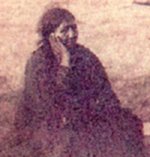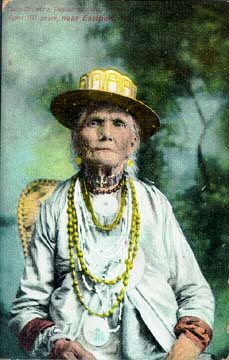The Women Who Support





![]()
![]()
![]()
![]()
![]()
![]()
![]()
As a Diabetic myself,
and knowing the statistics of Native people who also have the disease,
I wanted to add this info to today's page.
It's a different way to support. I wrote this page up
in 2006 so the stats have probably changed a bit, hopefully for the
better. I thought it would be interesting for those who do ceremony,
and powwows - Gloria
Diabetes and Ceremony
Diabetes affects both women
and men so on this page I have not concentrated on only the female aspects.
I hope that this will be acceptable because of the severity of the disease
in Indian Country.
However because this year's site
is about Native American women I would like to give some statistics
of the disease on the women before the rest of the information is given:
|
Type 2 diabetes
is a serious chronic health problems facing Native American women.
Approximately one third of American Indians aged 45 or older have
diabetes. (1)
|
|
Native American
women suffer from the second highest rate of being overweight,
which places them at a higher risk for diabetes. (2)
|
|
Native American
women have the highest age-adjusted death rates for diabetes,
one that is 3.5 times greater than the overall population. (3)
American Indian/ Alaska Natives are almost 3 times as likely to
have diabetes as non-Hispanic whites. (3)
|
|
The mortality
rate for American Indian women living in New Mexico has increased
550% over a 30-year period. (4)
|
|
Rates of end-stage-renal-disease,
a complication of diabetes, are increasing at a rate of 10% per
year for American Indian/ Alaska Natives compared to 6% per year
for whites. (5)
|
1. Making the Grade on Women's Health: A National and State-by-State
Report Card: National Women's Law Center; August 2000.
2. Ross H. Lifting the Unequal Burden of Cancer on Minorities and the
Underserved: NCI Develops Strategic Plan to Reduce Cancer Related Health
Disparities. Washington, DC: Office of Minority Health, U.S. Department
of Health and Human Services; August 2000.
3. National diabetes statistics fact sheet: general information and
national estimates on diabetes in the United States, 2000. Department
of Health and Human Services, National Institutes of Health, Bethesda,
MD: National Institute of Diabetes and Digestive and Kidney Diseases;
2002.
4. Carter JS, Wiggins CL, Becker TM, Key CR, Samet JM. Diabetes mortality
among New Mexico's American Indian, Hispanic, and non-Hispanic white
populations, 1958-1987. Diabetes Care. 1993;16(1):306-309.
5. Healthy People 2010, 2nd ed. Washington, DC: U.S. Department of Health
and Human Services, U.S. Government Printing Office; November 2000
2019 the above statistics were from an organization woman can do .org
who don't seem to exist any longer.
Powwows and Potlucks
Nothing beats getting together,
having fun and eating with friends; that is what powwows and potlucks
are all about. The happiness and laughter are all good medicine for
you. They lower your stress and lift your spirits. But all that food
and all that great tasting fat can pose a challenge to someone with
diabetes. Here are some suggestions on how to eat right at powwows and
potlucks.
| Have a snack before going to
take the edge off your appetite, spread out the food and decrease
the resistance to sugar uptake. |
| Bring your own water or diet
pop. Drinking them will help reduce your appetite |
| Take the opportunity to try
low fat foods prepared in new ways. Take small servings and try
more dishes. You can get chips and dip anytime. |
| Use smaller plates that hold
less food. Pace yourself between trips. It takes the stomach 15
- 20 minutes to know it's full. |
| Bring a dish to the potluck
that shows how great a low fat dish can taste. |
| Look for interesting salads,
fresh fruits and vegetables. |
| For the dishes you like, go
back for the recipe not seconds. |
| If you take something that
isn't worth the calories, don't finish it. If your auntie made it,
eat a polite amount and compliment her. |
| Plan to walk or dance off some
of the extra calories. |
| If you plan to deal with overeating
by skimping during the days before and after, make sure to adjust
your medications, and check your blood sugars. |
Remember to have fun and enjoy the
company.
Dancing
The drum has been called the
heartbeat of mother earth and dancing is a way of experiencing that
heartbeat. Dancing can help you feel the connection to your ancestors
and their strength and courage. It also helps you feel connected with
your children, grandchildren and the others at the powwow. It is for
them you are managing your diabetes. Some have found dancing lowers
their stress and helps control their blood sugar long after the dance.
To get the most from your dancing, consider the following:
| If your dancing is quite strenuous,
and you are taking diabetic medications such as insulin or oral
drugs that stimulate insulin production you may need to add some
carbohydrates to avoid low blood sugars. |
| The low blood sugar effect
may be delayed several hours; test and eat after dancing. |
| Very strenuous exercise can
dehydrate you, resulting in elevated blood sugar. If your blood
sugar is already above 300 (250 if ketones are present), you should
get your blood sugar under better control before dancing. |
| If your blood sugar is below
100 take a snack to get it up before dancing. |
| Regardless of your blood sugar
drink plenty of water; regalia can get very hot. If you are going
to do a sweat before or after dancing, drink extra water to avoid
dehydration and high blood sugars. |
| Have someone at the dance be
aware of your diabetes; someone you would be comfortable asking
to help if you have symptoms of high or low blood sugar. Wear a
medical alert ID and carry a fast acting source of sugar. |
| Make sure your shoes are comfortable.
Wear moccasins with hard soles or insoles or padding along with
thick socks. Check your feet after dancing. |
| If you have retinopathy check
with your ophthalmologist before starting strenuous dancing. |
| Finally, check your cardiovascular
health with your health provider especially if you are new to dancing.
Diabetes dramatically increases the chances of you having a heart
attack or stroke so make sure you know their warning signs and symptoms. |
Talk with others who have diabetes
and dance. Don't stop dancing just because you have diabetes; it may
be just the medicine you need.
Sweat Lodge
You sweat a lot in a sweat
lodge, and the sweat gives you a sense of special cleaning and renewal,
from the inside out. The sweat lodge is used for purification by itself
or as preparation for other ceremonies, for example the Sun Dance, and
the Vision Quest. The sweat lodge can strengthen your spirituality.
For a person with diabetes, a sweat lodge can reduce the stress in their
lives and renew their determination to manage their disease. Some have
found that sweats bring their blood sugars back to normal. Here are
some suggestions that will help make a successful Sweat Lodge experience.
| Drink enough water before a
sweat; the excess sweating can dehydrate you and increase your blood
sugar. If your blood sugar is already above 300 (250 if ketones
are present), you should get your blood sugar under better control
before before doing a sweat. |
| Sweating in sweat lodge is
not the same as sweating from exercise but it can still drop your
blood sugars. Check your blood sugar after a sweat if it is your
first time or if you are medicating your diabetes with insulin or
oral drugs that stimulate insulin production. |
| If you are going to a sweat
before or after a Vision Quest or during a Sun Dance, drink extra
liquids to avoid dehydration. Take liquids if they are offered between
doors. |
| Do not go into a sweat lodge
alone; have someone in the sweat be aware of your diabetes. The
Sweat Lodge is such an intense experience that you cannot rely on
your feelings that normally indicate high or low blood sugar. |
| Make sure you don't burn your
feet on the rocks, the hot coals or the hot spray. Sit as far away
from the rocks as practical. Check the position of your legs before
the door is closed and between doors. Protect your feet with a towel. |
| Finally, since diabetes dramatically
increases the chances of you having a heart attack or stroke, make
sure you know their warning signs and symptoms. |
Sweat Lodges are an important way
to connect with yourself, your spirituality and your tribe and heritage.
Talk with others who have diabetes and have done sweats. Your health
care provider can help you contact leaders who have experience accommodating
people with diabetes. Do not stop going to sweat lodges just because
you have diabetes, they may be just the medicine you need.
Vision Quest
The vision comes during isolation,
but the understanding comes by going back to the community. It is this
dual nature of the Vision Quest that has made it a powerful ritual with
Native Americans. A Vision Quest is where a person withdraws to an isolated
area (often a hill) and fasts and prays for the spirits to give a dream
or vision through which he or she can achieve a better life or a better
life for his or her family and community. As a result, a Vision Quest
can be a critical element in a person's ability to manage their diabetes.
However a Vision Quest for a person with diabetes poses some medical
challenges but with proper preparation they can participate. Most diabetic
treatment plans are focused on utilizing food properly; it may take
some effort to develop a plan for fasting.
It is important to control your
blood sugar while fasting. Out of control blood sugar can affect your
senses and hide any visions from the spirits.
These are some suggestions:
| With your health care provider
develop a treatment plan that can be used with fasting. Be patient,
it may take several weeks before you will know how your body responds
to fasting. |
| Drink plenty of water before
starting the Quest. If you are going to do a sweat before or after
a Quest, drink extra water to avoid dehydration. |
| Start by fasting for only one
day and test your blood sugar several times. It is important to
have experience with fasting before undertaking even a one-day Vision
Quest. |
| Arrange to have one or two
friends observe you unseen during your Quest. Arrange to go through
a routine that will allow the observers to judge how you are feeling. |
| Longer fasts require more elaborate
preparations and treatment plans. Remember to check your blood sugar
often. |
| Finally, since diabetes dramatically
increases the chances of you having a heart attack or stroke, make
sure you know their warning signs and symptoms. |
Talk with other people who have
diabetes and have undertaken Vision Quests. Talk with the spiritual
leaders. Your health care provider can help you contact leaders who
have experience accommodating people with diabetes. They can help you
avoid the potential problems and gain the benefits of one of the most
profound experiences in Native American life.
Sun Dance
The Sundance Ceremony is one
of the most dramatic of Native American ceremonies but it is still fundamentally
spiritual to the people who take part. Four days of outdoor dancing
and visiting with friends and relatives from across the country is very
spiritual. For those who choose to undergo the piercing and tearing
of their flesh, the pain and its release can put the everyday challenges
of managing diabetes in a new perspective. A number of Native Americans
with diabetes have used the Sundance to develop the deep spirituality
needed for managing their diabetes. The Sundance can make living with
diabetes seem easy.
| Use the pledge year before
the Sundance to minimize your medications through diet and exercise
while maintaining good sugar control. Both traditional and western
medicines can help you do this. |
| Test your blood sugar regularly
throughout the Sundance. If you are going to fast during the Sundance,
develop a treatment plan with your health care provider that can
be used with fasting |
| If you are going to do a sweat
during the Sundance, drink plenty of liquids to avoid dehydration
and high blood sugars. |
| New wounds should be treated
as soon as practical to speed the healing. |
| Finally, since diabetes dramatically
increases the chances of you having a heart attack or stroke, it
is important that you know their warning signs and symptoms. |
Talk with other diabetics who have
gone through a Sundance. Talk with the leaders. Your health care provider
can help you contact leaders who have offered to guide those who truly
want to undertake a Sundance but are concerned about their diabetes.
They can help you avoid the potential problems and gain the benefits
of one of the most profound spiritual experiences in Native American
religion.
In my own experience of going
to Sundance for 12 years, I wish to add that the leader allowed those
with diabetes to wear moccasins and drink sage tea to help them - GHD
© all the above writing on
the ceremonies and diabetes - Porcupine Clinic, Porcupine SD
The Porcupine Clinic in Porcupine South Dakota (Pine Ridge Reservation)
has developed guides for people who have diabetes and wish to take part
in Lakota Ceremonies. The guides are now being adapted to the ceremonies
of the Dakota and Ojibwa Tribes in South Dakota and Minnesota. The guides
have been found useful for a number of people who advise diabetic Native
Americans.
These pages from the past few days
come from a web site I created called Ancient Voices in 2006.
It was for a Museum I had made in the Little Feather Center, Pipestone.
If you would like more info on any of the women I have used on these
pages please let me know.

